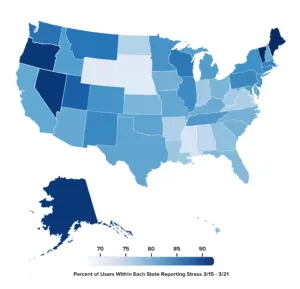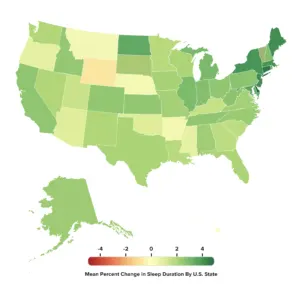Topics
- Article
- COVID-19
WHOOP Member Data in the Time of COVID-19

We’ll cover the ways in which WHOOP data is reflecting the global pandemic and how best to leverage WHOOP during this time.
If you’re feeling stressed, you’re not alone. For many members of the WHOOP community, the coronavirus (COVID-19) represents a first in their lifetime. The first time their school has closed its doors, the first time they’ve been asked to work from home, the first time they’ve been told to “stock up” on essentials, the first time an important competition they’ve trained for has been canceled. Times like this are difficult and can have an effect on your physiological and mental health. Now more than ever it’s important to pay close attention to the signals your body is sending. Here we’ll cover the ways in which WHOOP data is reflecting the global pandemic and how best to leverage WHOOP during this time.
How Does COVID-19 Manifest in WHOOP Data? (Resting Heart Rate, Heart Rate Variability & Respiratory Rate)
As you may have already noticed, when you get sick, your resting heart rate tends to increase and your heart rate variability tends to decrease. While you might see these changes in your WHOOP data, during the early stages of an infection, we often don't experience obvious symptoms. The immune system and the central nervous system work together in complex ways to target a foreign virus even before we're aware that we are sick. When infections become severe enough, one coordinated attack these two systems produce is the febrile response, commonly known as a fever. When the immune system detects a foreign pathogen such as a virus or bacteria, it sends a signal to the brain to increase the body’s core temperature, causing the sympathetic nervous system to respond by producing more heat. By creating a personal baseline while you are healthy, WHOOP can be used to identify signs of illness sometimes before you actually feel sick and potentially before a doctor - without recent data of what your personal “normal” looks like - would recognize that something was wrong. Doctors are taught that a heart rate between 60 and 100 bpm and a respiratory rate between 12 and 20 are in the “normal” ranges; however if the doctor knew your resting heart rate or resting respiratory rate for the last 14 days, the “normal” range becomes irrelevant and actual acute changes can be understood. WHOOP members are on average more fit than the general population, making their biometrics - specifically, heart rate, respiratory rate, and heart rate variability better than average. If those values declined into the “average” range, it may not raise red flags in the emergency room, but being relatively tachycardic (high heart rate) or tachypneic (high respiratory rate) is still physiologically meaningful as it would indicate that your body is suddenly working much harder at rest. Learn More: The Importance of Respiratory Rate Tracking During The COVID-19 Pandemic Due to wide-spread shortages of COVID-19 tests in the US, most WHOOP members with suspected cases of COVID-19 have been unable to confirm the diagnosis. Among those who were able to access testing and tested positive, at the time of publishing, eight had consented to sharing their data with the WHOOP community. Of those eight, five experienced a decrease in heart rate variability of 30% or more compared to a recent baseline, four experienced an increase in resting heart rate of 25% or more, and three experienced an increase in respiratory rate of 15% or more. To put these statistics in perspective, we looked at data from all WHOOP members that reported feeling sick for any reason during January of this year. Less than 15% of these members experienced a decrease of 30% or greater in heart rate variability, less than 5% of members experienced an increase in resting heart rate of 25% or more, and less than 1.5% of members experienced an increase in respiratory rate of 15% or more.
Coronavirus Pandemic-Related Stress and WHOOP Data
While we won’t all be infected by the SARS-CoV-2 virus, it doesn’t mean that we aren’t being impacted by the pandemic and the havoc it is causing. Uncertainty about the economy, loss of childcare or employment, transitions to working from home, and concerns about our sick or at-risk friends and family are causing some serious stress. Stress across the WHOOP community is at an all time high, with areas currently hit hardest by the SARS-CoV-2 virus under more stress. We show rates of self-reported stress from 3/15 to 3/21 broken down by U.S. state below. Notice that even in the least stressed states, over 70% of WHOOP Journal respondents indicated experiencing stress during that time frame.

Stress causes the sympathetic side of your nervous system to activate, increasing your resting heart rate and decreasing your heart rate variability. You can see this in one of our teammate’s data, below, as we transitioned to working from home last Monday and came to terms with the challenges of social distancing.

Sympathetic activation, and the decline in HRV it causes, is a normal response to stress and has served humans well for centuries. Imagine a scenario in which you encounter a saber-toothed tiger; sympathetic activation increases your heart rate and respiratory rate, sending extra oxygen to your brain to increase alertness, and extra energy to your muscles to respond to the predator. This stress response can be beneficial – when you are face-to-face with a life threat. However, this response can be misguided in situations where mental acuity and increased muscular response are not beneficial. In addition, triggering this stress-response many times each day can take a toll on your body; prolonged periods of stress are known to weaken the body’s immune system. Fortunately, there are a variety of ways known to decrease stress like physical activity, meditation, and sleep. Use WHOOP to hold yourself and others in your community accountable for continuing to engage in restorative behaviors during this stressful time. Loneliness also causes a similar reaction to stress in your body. So after you buy those extra cans of chicken soup to prepare for social distancing, make sure to also schedule a video chat with your friend or give your usual lunch buddy a call. Studies have shown that perceived social isolation has a similar effect to stress. And for good reason; for our ancestors, ostracization from the group meant facing that saber-toothed tiger alone. The upside, however, is that physical isolation doesn’t have to mean social or emotional isolation. Take advantage of WHOOP Communities. Connect with others through video chat, join an online workout, organize a virtual book club, or live stream a concert.
The Silver Lining: More Sleep
It turns out, social distancing isn’t actually all bad. As WHOOP members start to adopt social distancing practices, restaurants and bars close their doors, people regain time spent commuting, and bring their lives indoors, we’ve seen a significant increase in sleep. On average, WHOOP members were getting about 15 minutes more sleep per night this past week than they had the previous week. While this may be merely a side effect of canceled social calendars, research suggests that this extra sleep will likely translate to an extra boost for your immune system. You can see this trend in the graph below, which shows the average sleep attained by WHOOP members from February 21st through March 22nd of this year. You will notice that overall, members tend to sleep more on the weekends and less during the week, but that on Monday to Friday of this week we averaged what looks more like weekend levels of sleep than typical weekday levels of sleep.

Just as the coronavirus hasn’t hit all parts of the world or all parts of the US equally, this increase in sleep is more extreme in some parts of the country than in others. Interestingly, we are mostly seeing that US states hit the hardest by the virus are experiencing the greatest increase in sleep, while states with relatively fewer cases of COVID-19 are experiencing fewer extreme changes (or no changes) in their sleep behavior.

How Can I Leverage WHOOP During the COVID-19 Pandemic?
If you have been diagnosed with COVID-19 and are willing to allow WHOOP data scientists to look at your data, let us know at support@whoop.com. If you are not experiencing COVID-19 symptoms and haven’t come in contact with the virus, pay attention to your recovery and listen to your body.
- Get plenty of sleep. Improve your immune system with additional sleep. Use the Sleep Planner to determine daily sleep need and the optimal bedtime.
- Keep up physical activity, but don’t overdo it. Use the Strain Target to determine what level of exercise is appropriate. Studies have shown that moderate levels of exercise enhance your immune system while too much exercise can suppress your immune system. The WHOOP Strain Target can help you identify the optimal cardiovascular load to take on each day in order to maximize your ability to fight off infection should you become exposed.
- Track behaviors and symptoms with WHOOP Journal. The WHOOP Journal feature allows you to be scientific in your approach to training by running self-guided experiments with your data.
- Use WHOOP Communities. Connect with your peers and challenge each other to sleep, train, and recover better.
Finally, keep in mind that the situation is constantly evolving. What’s recommended today may not be recommended tomorrow. Stay informed with live updates from reputable health organizations like the World Health Organization and the Centers for Disease Control. Learn More: COVID-19 Research, Data & Resources - Tips for Tracking Your Health During a Pandemic Please keep in mind that WHOOP is not a medical device company, and our products and services are not intended to diagnose COVID-19, the flu or any other disease, and should not be used as a substitute for professional medical advice, diagnosis or treatment.